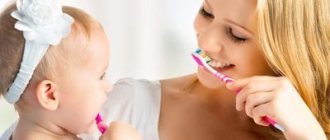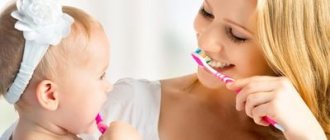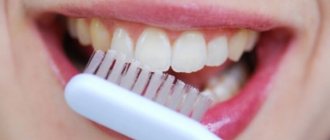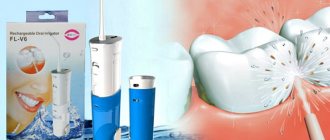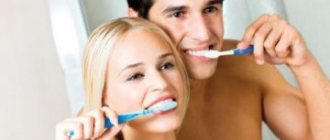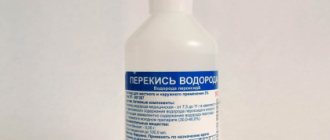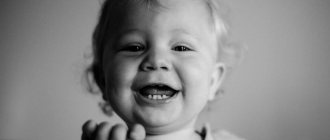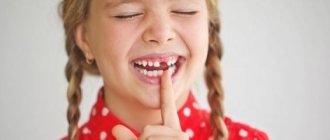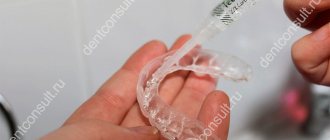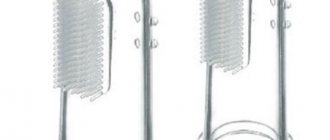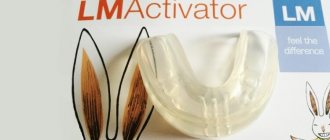From this article you will learn:
- When should you start brushing your baby's teeth under one year old?
- how to brush children's teeth at one year, 2 years and later,
- how to choose toothpaste for a child.
Baby teeth are very important for a child, because... they ensure jaw growth and also participate in the formation of correct pronunciation (diction). However, many parents make a number of mistakes that lead to early damage to baby teeth by caries, the subsequent development of pulpitis and periodontitis, and ultimately removal. At the same time, early removal of baby teeth causes disruption of jaw growth and delay in the eruption of permanent teeth.
Early caries of primary teeth is a consequence of - 1) insufficient oral hygiene in a child, which leads to the accumulation of soft plaque and an increase in the number of cariogenic bacteria, 2) improper diet, irregular feeding on demand or night feeding, 3) consumption of large quantities easily -digestible carbohydrates. There is even a term in dentistry - bottle caries, which shows the important connection between a child’s poor nutrition and the development of dental caries.
Caries of primary teeth in children -
Therefore, it is very important for parents to know when to start brushing their baby’s teeth, what toothpaste is best to use, and, in the future, how to teach their child to brush his teeth on his own when he reaches the appropriate age. Remember that soft flour and starchy foods (i.e., everything that contains easily digestible carbohydrates), sour and sweet juices, as well as soda - in conditions of insufficient hygiene quickly lead to the development of caries.
When to start brushing your baby's teeth
Hygienic care is necessary even before teething. The procedure must be carried out several times a day: after sleep and during the day after feeding.
The procedure for cleaning your baby's gums is as follows:
- place the child on your lap;
- take a gauze swab and carefully walk it over the surface of the gums. For greater convenience, you can wrap your finger with a bandage or use special finger pads, which can be purchased at the pharmacy.
It is enough to simply moisten the tampon with clean water, but for greater effect you can use foam designed just for such purposes (for example, SPLAT Junior (SPLAT Junior) for children 0-4 years old).
Foam is a modern, effective product that has many beneficial properties. Firstly, it contains lactic enzymes that protect the mucous membrane from infection and bacteria that cause various diseases (for example, stomatitis). Secondly, components such as creatine, arginine and others have an anti-inflammatory and calming effect, reducing pain during teething. Thirdly, many foams contain calcis or fluoride in small dosages (the former are best used before a year, the latter - after).
A FEW SECRETS OF SUCCESS
To make the process of teaching your child personal hygiene easy and painless, you should consider some simple but important recommendations.
- It is better to choose the first brush with your baby, he should like it.
- Diversity is also welcome! You can purchase several brushes so that your baby has a choice every day. This will help keep his interest.
- Maintain consistency. It should be clearly understood in the child’s mind that brushing teeth is a mandatory procedure that must be performed twice a day. Encouragement in the form of permission not to brush your teeth is unacceptable.
Praise must be present. You can use the oral form, or you can turn to visualization, for example, post a poster on which each successful brushing of teeth is marked with an asterisk, sticker or picture. The kid will try to replenish the “collection” and will show due diligence.
Experts advise against using material rewards, such as candy, for efforts. The child must understand from the very beginning that brushing his teeth is a mandatory hygienic procedure that he must perform for the sake of his own health. No one will give gifts for this.
In any case, you cannot force your child to brush his teeth; it is necessary to show attention, care and tact, to turn every visit to the bathroom into a fun game, only in this case the process will become as productive as possible. The sooner you start working on oral hygiene, the fewer possible problems you will have to deal with later.
Brush your child's teeth correctly
Teeth begin to erupt at about 6 months of age. Some children easily survive this period of time, others suffer from pain and experience great inconvenience.
Emerging teeth can be cleaned, just like the gums in the first months of a baby’s life: take a gauze swab, apply a special foam to it and rub it over the surface of the gums and teeth. Sometimes you can find finger pads with soft bristles on sale: they make the procedure much faster, better and more convenient.
Perhaps the baby will not like the procedure at first: you should not force things - it is better to give the child the opportunity to get used to it. When the baby is no longer nervous at the sight of tampons, you can move on to using a brush (there is no exact time frame for when exactly this should be done). You can hear from some dentists that it is advisable to use a brush after the appearance of at least 4 teeth in a row, others advise not to rush, waiting until the baby is 2 years old.
HOW TO BRUSH YOUR TEETH WELL?
It is important for parents not only to instill in their child the desire to keep the oral cavity clean, but also to teach him to brush his teeth correctly, properly removing plaque and food debris. To do this, you can use the following sequence of actions.
- Make movements to the right and left along the chewing surface of the lower teeth on both sides. Repeat with the top ones. The brush is held at an angle, the amplitude of its movement is short.
- Brush your front teeth up and down, then in a circular motion.
- Using sweeping movements, clean the back surfaces of the upper and lower teeth. The brush is in a horizontal position.
- In the same way, clean the teeth inside the mouth, above and below.
- The cleaning ends with a gentle massage of the gums.
Ideally, you need to repeat each movement 10 times, then move two teeth to the side. It is equally important to explain to the baby how to rinse the mouth: thoroughly, so that the water gets on all the teeth, and then spit it out (you can’t drink this liquid now).
Brushing your teeth
Cleaning should be done after waking up and before going to bed. The duration of the procedure is at least 2-3 minutes. Particular attention should be paid to chewing teeth, since they contain small grooves where bacteria accumulate and caries begins to form.
Not all children enjoy brushing their teeth: some may become capricious, nervous, and break out. First of all, you need to make sure that the fear goes away: brushing your teeth can be turned into a game, for example, you can let your child brush your teeth, and you brush them for him.
High-quality toothpaste and brush are of no small importance for hygiene, but their use is clearly not enough: once a day you need to floss (by the way, this advice applies not only to children, but also to adults). Floss can remove small food debris from dental spaces that are difficult to reach with a brush. Carious formations appear primarily in such places, since an excellent environment for the growth of bacteria is created there.
BRUSH SELECTION
For children over one year old, it is important to choose the right toothbrush; it must meet the following requirements:
- presence of a limiter on the handle;
- rubber fluffs.
After 3 years, you can switch to classic models with short handles and soft bristles, the working surface is no more than 2.5 cm. It is desirable to have silicone inserts on the handle, they will help prevent the “tool” from slipping in an unsure child’s palm. When the paste is used, you can consider options in which the area on the bristles is highlighted in color for the placement of the paste.
Which toothbrush should you choose?
Children's toothbrushes, without exception, have soft bristles. It is distinguished from an adult brush by a smaller head, which can be rubberized, which is done to reduce the risk of injury during the cleaning process.
The packaging of most brushes for children contains information about the age they are intended for: these recommendations should not be neglected. It is better to choose a brush with an unusual design that can attract the child’s attention and make him more willing to brush his teeth.
The brush should be changed once every 3 months, or better yet more often: you need to monitor the condition of the bristles, and not hesitate to replace them when they begin to deteriorate. The point here is not only the lack of aesthetics, but also the loss of functional qualities: if the bristles are fluffy, then it will be difficult to remove plaque, which is fraught with unpleasant consequences.
Each family member should have their own brush!
Recently, electric toothbrushes have become increasingly popular. There are special children's brushes that can be used after 3 years. Practice shows that children show more interest in electric toothbrushes than in regular ones. Again, each child should have their own personal attachment.
Why should you brush your baby teeth?
Many young mothers believe that brushing their baby teeth is not necessary because they will fall out anyway. However, decaying teeth
are always pain, discomfort and a source of spread of pathogenic bacteria.
How to brush your teeth correctly
How often, what to use, and in what mode is it better to brush your teeth? Detailed instructions for children and adults.
In addition, the early habit of brushing teeth becomes natural for the child and will help him preserve the health of his molars.
Which pasta should you choose?
Before buying toothpaste, many modern parents go online to read reviews, but you shouldn’t trust them: many reviews are left on request in order to increase sales. The advertising is aimed primarily at women, since they are usually the ones who buy such things.
The main myth that can often be found in such reviews is the enormous harm of fluoride for children.
Fluoride or calcium: which is better for a child?
Fluoride is not poison at all. This substance is beneficial, including for children. Dental societies in many countries around the world have conducted studies that have proven that fluoride-containing toothpastes are absolutely not harmful.
You can often see that children should use a paste containing calcium, but this is not at all true.
When choosing pasta, you need to take into account the age of the direct consumer.
- Children under 1 year. This is the only age when it is better to purchase a paste with calcium in its composition, since during this period of time the tooth enamel is still quite weak and contains few minerals. Children often swallow the paste, so it should not contain parabens and sodium lauryl sulfate, which pose a health hazard. Fluoride-containing paste can be dangerous only where there is an increased fluoride content in the water: an excess of this substance can cause the development of fluorosis. If a filter is used, it can retain most of the fluoride, which will lead to its deficiency and, as a consequence, the development of caries. Read more about children's toothpastes here.
- Children from one to 6 years old. During this period, you can use a paste with fluoride, making sure that its content in the composition does not exceed 500 ppm. Pastes with calcium can also be used, provided that the child either does not have caries at all, or a single case of carious formation has been recorded.
- Children over 6 years of age. For children of this age, the concentration of fluoride contained in the paste should be increased to 1000 ppm.
Advice for parents who want to rid their child of dental problems:
- It is better to alternate different pastes: use a paste with calcium in the morning, and one with fluoride in the evening.
- You can get by with a calcium paste, but after each brushing, rinse your mouth with a special fluoride-containing liquid. Remember that such a liquid cannot replace a thorough cleaning!
What should the first brush be?
Dentists recommend switching to brushing with a toothbrush when baby teeth are at least halfway through. Your first toothbrush should have a compact head and synthetic bristles. In addition to the usual toothbrush, you can use a silicone finger brush: it massages the gums and relieves itching.
4 principles for choosing your first toothbrush:
- The head of the brush should be small and cover two teeth, no more. It will be very difficult to thoroughly remove plaque with a brush with a large head due to its clumsiness.
- The brush head should have silicone pads to make cleaning safe. For babies under one year old, a protective silicone ring (limiter) will not be superfluous.
- The bristles should be soft, thick and short.
- The handle of the brush should be comfortable for both the child and the parents.
From the age of 1 year, it is important to motivate children and fuel their interest in the cleaning process. Research has shown that using electric toothbrushes can be a way to build motivation. In addition, switching to an electric device improves oral hygiene compared to a manual brush: the amount of cariogenic microflora in saliva is reduced, and the risk of developing caries is reduced.
An electric toothbrush at an early age will allow the child to get used to the vibrations in the mouth, and it will be more convenient for parents to reach the distant teeth.
3 principles for choosing your first electric toothbrush:
- For children under 5 years old, it is recommended to choose models with extra soft or soft bristles.
- If the first electric brush has a bright design depicting fairy tale or cartoon characters, the child will form a pleasant association with brushing his teeth.
- The size of the brush head should not exceed 2 cm, and the handle should be rubberized. This way, the child will gradually begin to pick up the brush on his own, and the small head will allow him to brush his teeth more thoroughly.
CURAPROX Curakid Baby (0 to 4 years)
CS Medica CS-561 Kids (from 1 to 5 years) Yellow
Mega Ten Kids Sonic Kitten
Hapica Baby DBB-1Y (from 1 to 6 years)
Pastes to relieve painful symptoms during teething
There are several toothpastes designed to reduce the pain associated with teething.
In addition to the paste indicated at the very beginning of the article, we can recommend:
- Gel paste “Weleda” (Weleda) with calendula;
- ROCS Baby (ROKS Baby) with chamomile extract.
Both products will help your baby cope with pain.
Children brushing their teeth: how to add mindfulness to the game
Children are usually ready for this stage at the age of 2–3 years. Action plan for parents:
- the baby stands in front of the mirror, and the parent stands behind him;
- the baby holds the toothbrush himself, and the parent holds his hand;
- Mom or dad gently guide the baby’s movements: the movement of the brush should be from the gum to the edge of the tooth;
- Parents ask the baby to rinse his mouth and finish brushing his teeth.
This simple lesson should be repeated every day, gradually offering the child more and more independence.
Pastes for children with stomatitis
Stomatitis occurs quite often in children. It is much easier to prevent the occurrence of a disease than to treat it later.
High mucosal immunity is the best protection against stomatitis. Enzymes (lactoferrin, lysozyme, etc.) included in the composition of children's pastes from SPLAT: Junior and Juicy Set have a beneficial effect on the immune system.
Rules of care
6-8 months is the approximate time interval at which time you should start brushing the teeth of a child whose baby incisor has just emerged. However, you should take care of your mucous membranes, tongue and gums almost from birth.
There are many modern accessories for painless and safe procedures, suitable for different age categories. Before buying such a product, it is useful to read the labeling on the packaging and make sure that it is exactly intended for the baby.
First teeth
Oral care should be carried out immediately after discharge from the maternity hospital. Parents should wipe soft tissues with a napkin soaked in water, herbal decoction or bactericidal alcohol-free infusion.
When baby incisors appear on the surface, you need to purchase a silicone brush tip. With its help, plaque is removed and painful mucous membranes, inflamed and swollen due to teething, are massaged.
Useful tips:
- movements – “sweeping”;
- the nozzle should be placed in the child’s mouth at an angle of 45 degrees to the gums;
- the inner dental part is cleaned with short strokes;
- Each unit is given up to 15 seconds.
Child under 1 year old
Children at 8-10 months still have too few teeth, so you don’t need to use either a brush or toothpaste. It is enough to take a piece of gauze, moisten it in warm boiled water and wipe the oral cavity.
During teething or gum inflammation, it is recommended to regularly use herbal infusions. When there are no dental diseases, you can resort to cleaning with herbs once a week for preventive purposes.
A soft silicone brush that fits on your finger will also work. It is necessary to clean not only the internal and external surfaces of the teeth, but also the tongue, gums, and the space behind the cheeks. You can brush your one-year-old child’s first teeth with either damp gauze or special dental wipes for the little ones, sold in pharmacy chains.
All manipulations should be carried out extremely carefully. Teething causes severe discomfort, and the baby will not like it if parents increase the unpleasant symptoms while performing hygiene procedures.
Children over one year old
You can purchase a special brush with silicone bristles. It is soft and does not damage mucous membranes. For such an accessory, relatives will have to pay a little more than for a regular one, but all expenses will be justified.
With this product, food debris and bacteria are removed, while the enamel remains intact, and there is no damage to the inside of the cheeks, gums and crowns. Cleaning will not cause any discomfort.
The only drawback of silicone brushes is their short service life. They should be periodically replaced with new ones.
What happens if you don't brush your teeth well enough?
Some parents are not serious about brushing their children's teeth, believing that the child is already fine, which is a misconception.
Poor hygiene is a consequence of the appearance of microbial plaque and stone formation, which can cause:
- gingivitis;
- caries;
- stomatitis;
- pulpitis;
- formation of purulent seals on the gums.
Consequences of poor oral hygiene in children -
Many parents either take their children's oral hygiene very lightly or consider the current level of hygiene to be good. But in the vast majority of cases this is self-deception. Insufficient hygiene primarily causes the accumulation of soft microbial plaque and tartar, which in turn leads to –
- to the appearance of gingivitis in a child,
- to tooth destruction by caries,
- to the development of pulpitis and acute pain,
- further - to the appearance of fistulas and purulent bumps on the gums in the child, which will require the mandatory removal of the causative milk teeth. We hope that our article: At what age should a child brush his teeth was useful to you!
Sources:
1. The author’s higher professional education in dentistry, 2. Based on 20 years of personal experience as a dentist, 3. The European Academy of Paediatric Dentistry (EU), 4. National Library of Medicine (USA), 5. “Pediatric therapeutic dentistry. National leadership" (Leontyev V.K.).
Choosing a toothpaste for a child
Children's pastes have a lighter and softer composition. These are non-abrasive pastes with a pleasant taste, created specifically for children's enamel of baby teeth. For children under 3 years old, hypoallergenic pastes without fluoride are produced, and at the age of 4–7 years it is already necessary to add this component to strengthen the enamel. In the period up to 12 years, the amount of fluoride decreases again - these pastes already resemble adults in composition.
It is best to entrust the choice of toothpaste for a child to a dentist who has been observing the child from an early age. All children have their own characteristics - so it is the doctor who will select the paste that is really suitable.

